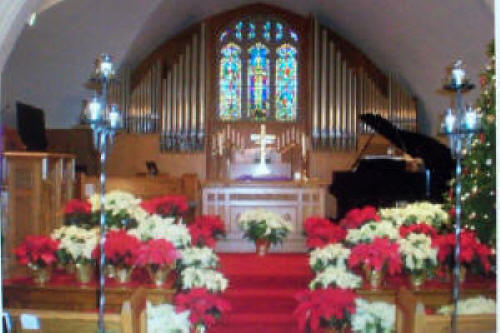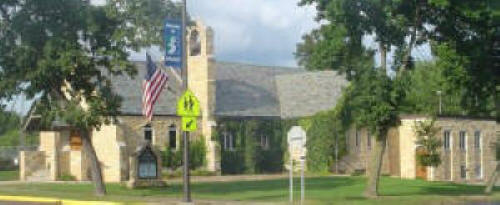| Builder: Hendrickson Organ Co, Opus 32, 1975 Manuals: 2 Stops: 11 Ranks: 13 Pipes: 764 Action: Direct Electric action. Notes: The organ is in a case at the front of the room. Non-traditional style console. The console is movable. --Information and photo from church website and the Hendrickson website. Last Update: 9/2012 GREAT ORGAN 8 Principal 8 Rohrflöte 4 Octave 4 Spitzflöte 2 Octave (ext 8' Principal) 1 Mixture III 16 Dulzian (ext 8' Krummhorn) 8 Krummhorn SWELL ORGAN 8 Bourdon 8 Gemshorn 8 Céleste 4 Principal 4 Spitzgedackt 2 Blockflöte 1-1/3 Quint 8 Krummhorn 4 Regal (ext 8' Krummhorn) PEDAL 16 Subbass 8 Principal 8 Gedackt 4 Octave 4 Gedackt 2 Gedackt 2 Mixture III 16 Dulzian 8 Krummhorn 4 Regal |
 |
 |
|
| The new pipe organ in the People's Congregational Church was
built by the Hendrickson Organ Company of St. Peter, Minnesota. The
design of the organ and its location in the church were arranged for
by the organ committee in discussions with Mr. Charles Hendrickson. The purpose of the pipe organ is to provide the instrumental music for the various services and events within the church, accompany the choir and soloists, and to encourage and inspire the congregation to sing. |
|
| The pipe organ is a highly developed musical instrument
whose many pipes require air to speak. It is a wind orchestra of
breathing, speaking instruments controlled by the organist through
the two keyboards for the hands and the pedalboard for the feet. It
is by far the most complicated and difficult musical instrument to
play. Its use within the church is very ancient and a thousand years
of development has brought us a wealth of music and sounds which the
western church finds indispensable for the worship life of the
congregation. The Hendrickson pipe organ has been installed at the front of the church in a manner designed to project the sound of the pipes throughout the room and with a physical arrangement which complements the gothic stained glass window. The two organ cases represent the pipes which are playable from the two keyboards of the organ console. When using the lower keyboards. the organist is operating the pipes in the left (north) case. When using the upper keyboard, the pipes in the right side case are made to speak. The lowest tones of the organ, which are played by the organist's feet, come from large pipes located in both cases. The console, which contains the controls and keyboards for the organist, has been made movable, and is connected to the organ by a cable containing over 200 wires. The console may be placed at any convenient position in the chancel area. The pipe organ was built in the Hendrickson shop in St. Peter. Mr. Terry Bateman was the shop foreman, and Mr. Robert Sperling voiced and regulated the pipes. Also working on the construction were David Engen, Peter Monkkonen, William Griffith, Robert Johnson. Andra Motter, John Martin, Paul Lutz, and Ken Stromberg. The metal pipes of the organ were made in Germany; the wood pipes were made in the Hendrickson shop. The organ was installed in the church and after everything was correctly operating and all the parts and pipes were functioning, the process of regulating the sound of the pipes was begun. Mr. Sperling, Mr. Engen and Mr. Hendrickson were responsible for adjusting the pipes for the proper sound in the room. Because the pipe organ was built specifically for the People's Congregational church and the physical requirements of the room, there is no other organ quite like this one in the world. It is a special and unique design created for the physical and musical requirements of this church. The pipe organ contains 764 pipes which are arranged to form 11 different stops or voices totaling 13 ranks. Six of the ranks are enclosed in an expressive swell box on the right side of the chancel. The remaining 7 ranks of pipes are completely exposed and are visible at the front and inside of the organ case on the left. The visible pipes at the front of the cases are the speaking pipes of the principal 8' and octave 4' ranks. |